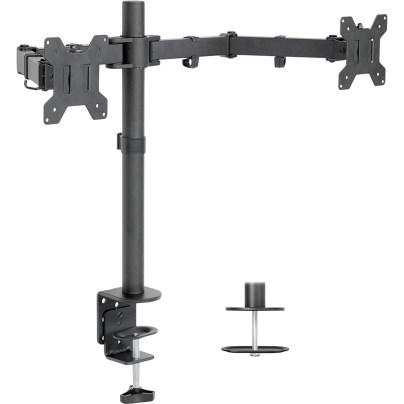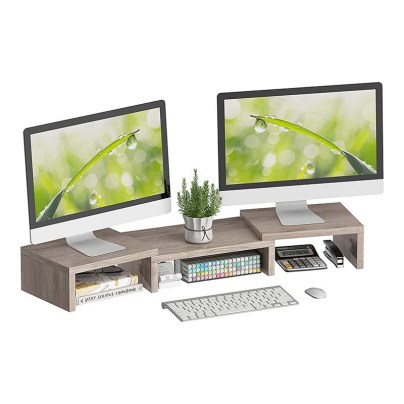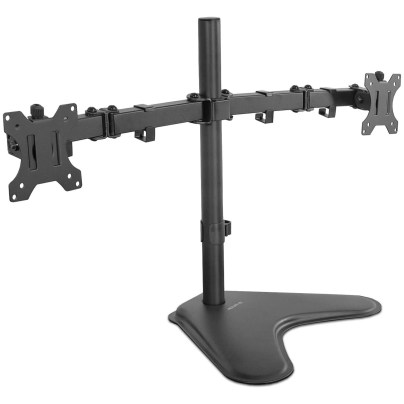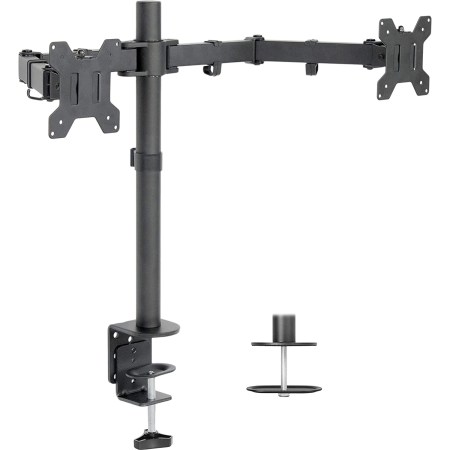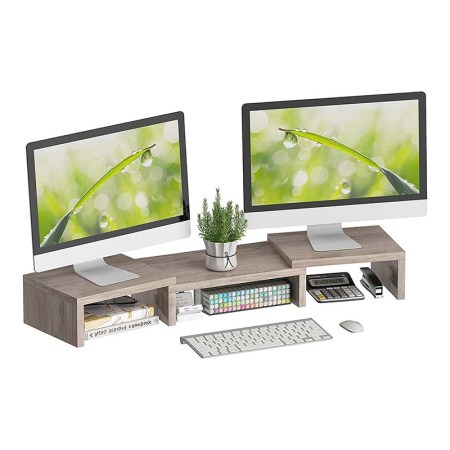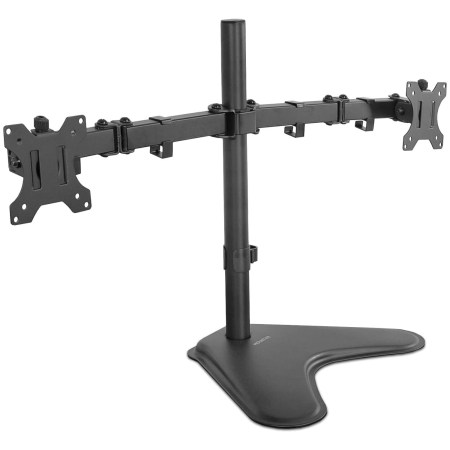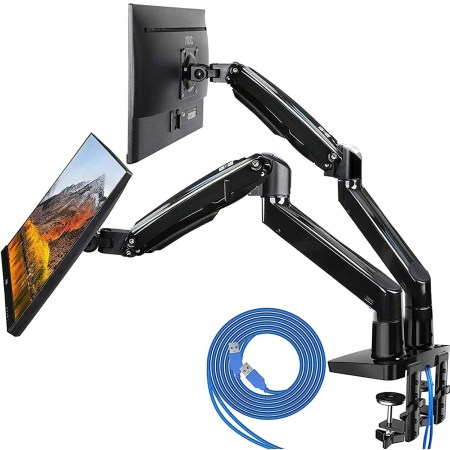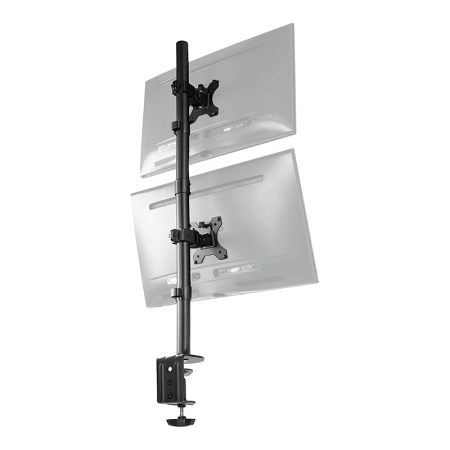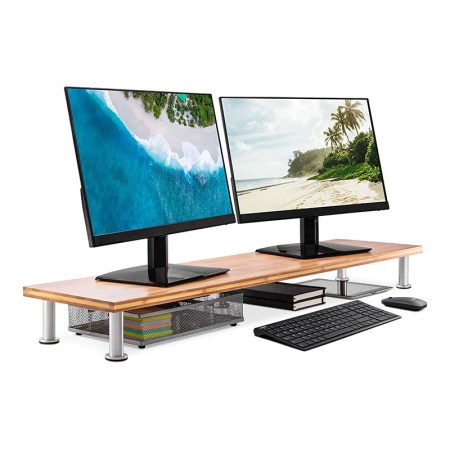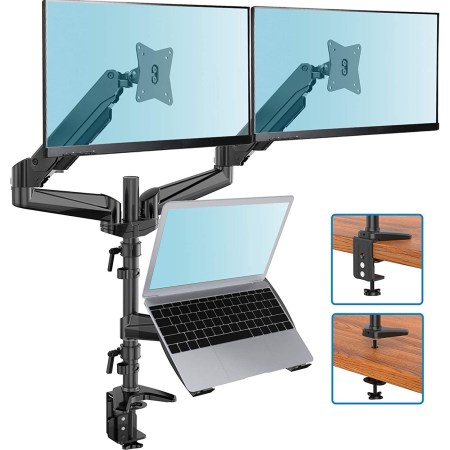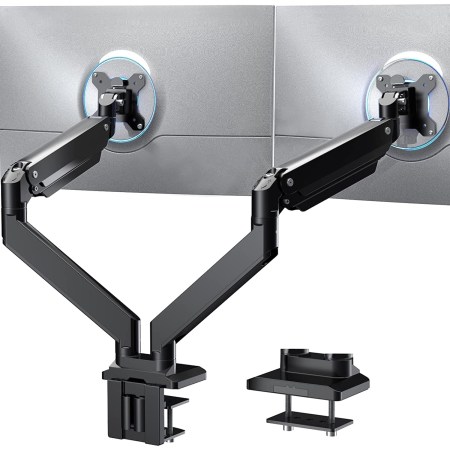We may earn revenue from the products available on this page and participate in affiliate programs. Learn More ›

Computer monitors have come a long way toward being more space saving and less cumbersome. Unlike early monitors that weighed dozens of pounds and took up nearly an entire desk space, today’s flat-screen monitors are relatively lightweight. Computers can host two or more monitors with dual-monitor stands, allowing each screen to be used for a different purpose. A home office’s primary monitor might be dedicated to spreadsheets or data entry, while a second monitor can display online research or show closed-circuit security-camera feeds.
Whatever a worker’s needs, the ability to connect a second monitor means not having to switch back and forth between applications on a single monitor. Plus, dual-monitor stands help position multiple monitors at an optimal height for viewing while keeping the desk space less cluttered and more organized.
The best dual-monitor stand varies depending on work habits, work-space size, and monitor sizes. Keep reading to learn about some of the key dual-monitor-stand features to consider, and find out why the following stands are well suited to a variety of work tasks and home offices.
- BEST OVERALL: Vivo Dual LCD Monitor Desk Mount Stand
- BEST BANG FOR THE BUCK: Superjare Monitor Stand Riser Adjustable Screen Stand
- BEST FREESTANDING ARMS: Mount-It! Dual Monitor Desk Stand
- BEST WITH LONG ARMS: Huanuo Dual Monitor Double Arm Mount Stand
- BEST VERTICAL-MOUNT: Vivo Dual LCD Stacked Monitor Desk Mount Stand
- BEST FOR LARGE DESK: The Office Oasis Large Dual Monitor Stand
- BEST WITH LAPTOP TRAY: Huanuo Monitor and Laptop Mount
- BEST FOR HEAVY MONITORS: Wali Dual Monitor Gas Spring Desk Mount
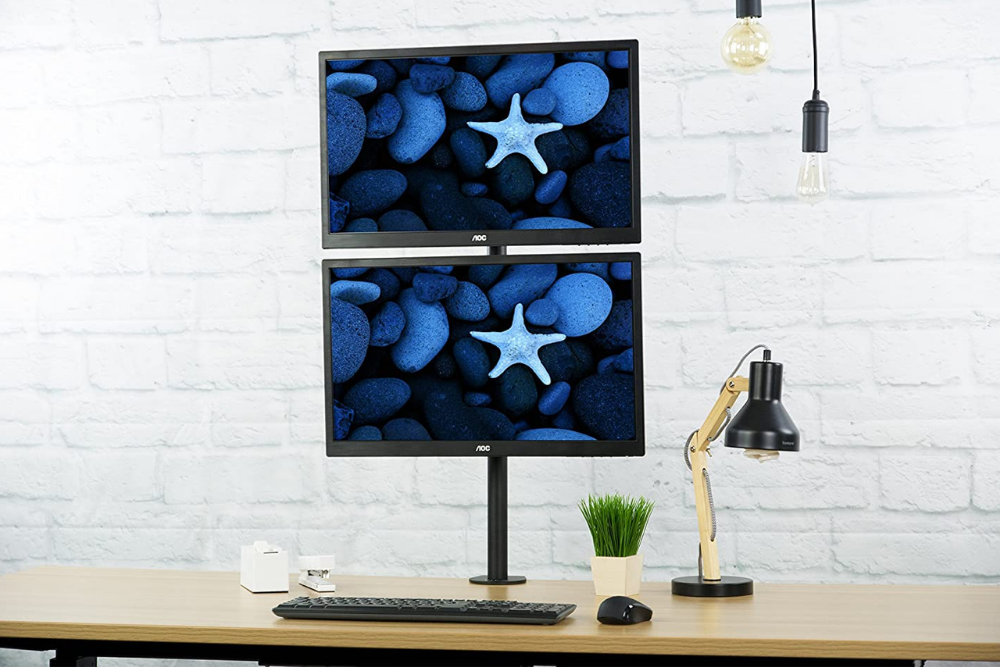
How We Chose the Best Dual-Monitor Stands
We researched the best dual-monitor stands in a variety of categories with high customer satisfaction. The list factors in screen size, tilt, swivel, and other key features included by the top brands. Most dual monitor stands on this list come with mounting hardware and Video Electronics Standards Association (VESA)-style mounting holes.
To accommodate a variety of monitor sizes, the majority of the top picks accommodate screens from 13 inches to 27 inches (the screens are measured diagonally), with some options capable of holding screens larger than 30 inches. Most of the best dual-monitor stands tilt and swivel for the ultimate adjustability. The list also prioritizes stands with key features like cord clips and an integrated cable-management system.
Our Top Picks
The best dual-monitor stands are more than just functional; they are designed to support a variety of monitors and help complement the design of a space. While the best dual-monitor stand will vary depending on needs and office configuration, the following stands are some of the best on the market with key features for user-friendliness.
Best Overall
Vivo Dual LCD Monitor Desk Mount Stand
See ItThe Vivo dual LCD monitor desk mount stand attaches to the back of a desk or tabletop with a heavy-duty grommet clamp, providing a secure and stable monitor foundation for most users. It can hold two flat-screen monitors ranging from 13 to 27 inches and up to 22 pounds each.
The mounting plates rotate to hold the two monitors in either landscape or portrait orientation. The stand comes with universal VESA bracket plates that will accommodate monitors with either 75-by-75-millimeter or 100-by-100-millimeter mounting holes. Users can reduce cord clutter by using the included clips to secure the cords along the sides of the dual monitor arms.
The Vivo stand allows full articulation of both monitors, including the ability to tilt and swivel to accommodate personal viewing preference. In addition to complete assembly instructions, the stand comes with the necessary tools for mounting the monitors, making it one of the most versatile stands in the lineup.
Product Specs
- Screen size: 13 to 32 inches
- Tilt: Yes
- Swivel: Yes
Pros
- Heavy-duty grommet clamp for a variety of monitor sizes
- Monitors can mount in landscape and portrait orientations
- Comes with universal VESA bracket plates and mounting hardware
- Includes cord clips to keep a desk space organized and decluttered
Cons
- Screen weight limited to 22 pounds; may not be ideal for some users
Get the Vivo dual-monitor stand at Amazon or Wayfair.
Best Bang For The Buck
Superjare Monitor Stand Riser Adjustable Screen Stand
See ItNo need to spend a lot of money to free up desk space and elevate two monitors to an optimal viewing level. The Superjare monitor stand riser features an adjustable base that can extend up to 36 inches in length for holding two large monitors on either side, or it can be shortened to 23.5 inches to hold a single monitor.
The stand’s outer bases also can be rotated inward at an angle to allow each monitor to face the center for easy viewing. The riser-type stand features a box-type base that’s 9.25 inches deep, making it large enough for supporting most monitor bases. The 3.94 inches of free space beneath the stand are handy for holding notebooks, essential papers, or other items.
The stand is made from particleboard covered with cream-gray laminate. This dual-monitor stand elevates two monitors for better visibility while freeing up desk space at a price that’s less than other types of monitor stands.
Product Specs
- Screen size: Up to 36 inches
- Tilt: No
- Swivel: No
Pros
- Adjustable base to meet individual preferences
- Space below base can be used to store office supplies
- Sturdy particleboard design
Cons
- Some reports of manufacturing defects
Get the Superjare dual-monitor stand at Amazon.
Best Freestanding Arms
Mount-It! Dual Monitor Desk Stand
See ItThose looking for a freestanding dual-monitor stand that will hold large monitors may benefit from the Mount-It! dual monitor desk stand that holds flat-screen monitors ranging in size from 13 to 32 inches. It allows users to position the monitors either in landscape or portrait orientation, and the stand’s dual monitor arms rotate and tilt for personal preference.
The arm height on the stand pole can be raised to 18 inches or lowered to just a few inches above the desk, as necessary. Its broad base stabilizes the monitors’ weight—up to 17.6 pounds per screen—without tipping. For best results, attach monitors of approximately the same size and weight.
The dual-monitor stand has a steel frame for durability. The arm attachments are compatible with universal, VESA-style mounting holes of either 75 by 75 millimeters or 100 by 100 millimeters. It comes with cord clips both on the dual monitor arms and the vertical pole to hold cords and keep the office organized.
Product Specs
- Screen size: Up to 32 inches
- Tilt: Yes
- Swivel: Yes
Pros
- Durable steel frame lasts for years without bending or breaking
- Can position monitors in landscape or portrait orientation
- Compatible with universal VESA-style mounting holes
- Comes with cord clips to keep a space decluttered
Cons
- Screen weight limited to 22 pounds
Get the Mount It! dual-monitor stand at Amazon or Best Buy.
Best With Long Arms
Huanuo Dual Monitor Double Arm Mount Stand
See ItWith the Huanuo long-arm dual-monitor stand, users can move each monitor forward or backward, upward or downward, and at virtually any angle to get the best viewing position. The arms on the stand extend up to 21.65 inches, allowing the user to pull one forward, push the other one backward, spread the two monitors apart, or keep them in close proximity. Each will support a monitor from 13 to 35 inches in size, weighing up to 26.4 pounds apiece. The arms both tilt and swivel for the best user experience.
The Huanuo dual-monitor stand attaches securely to a desktop or a tabletop and features an integrated cable-management system to keep cords from cluttering up the look of the office. The monitor’s attachment plates are VESA compatible and will accept monitors with 75-by-75-millimeter or 100-by-100-millimeter mounting holes.
Product Specs
- Screen size: 13 to 35 inches
- Tilt: Yes
- Swivel: Yes
Pros
- Highly adjustable; width and depth can be changed (and swiveled)
- Integrated cable-management system for decluttering
- Attachment plates are VESA compatible for user-friendliness
Cons
- Screen weight limit of 26.4 pounds; may not hold larger screens
Get the Huanuo double-arm dual-monitor stand at Amazon.
Best Vertical-Mount
Vivo Dual LCD Stacked Monitor Desk Mount Stand
See ItFor those who prefer mounting one monitor over another rather than side by side, the Vivo dual LCD stacked monitor desk mount stand does not disappoint. It features a 28-inch-tall bar that attaches firmly to a desk or table for stability and comes with two mounting plates. The plates can be adjusted up or down on the bar to suit different-size monitors, ranging from 13 to 34 inches and up to 22 pounds each.
The plates both tilt and swivel for adjusting the screens to an optimal viewing configuration. This Vivo stand comes with a cable-management system, with cable clips that keep the monitor cables neatly aligned along the stand’s pole.
The mounting brackets accept universal VESA-type monitor holes, measuring either 75 by 75 millimeters or 100 by 100 millimeters. Smaller monitors may be configured in either landscape or portrait orientation to suit individual preference. Minimal assembly is required, and step-by-step instructions are included.
Product Specs
- Screen size: 13 to 34 inches
- Tilt: Yes
- Swivel: Yes
Pros
- Comes with mounting plates for easy installation
- Includes a cable-management system to reduce cluttered appearance
- Mounting brackets accept universal VESA holes
- Smaller monitors can be mounted in landscape or portrait orientation
Cons
- Screen weight limit of 22 pounds; may not suit some users’ screens
Get the Vivo stacked dual-monitor stand at Amazon.
Best For Large Desk
The Office Oasis Large Dual Monitor Stand
See ItThe Office Oasis riser monitor stand sits on a desk or table and safely elevates two flat-screen monitors 4.25 inches higher than the work surface. The space between the stand and the desk offers extra storage room for papers, notebooks, or other office supplies. This large-size stand—42 inches from side to side and 10.5 inches deep—comes with sturdy steel legs for support and rubber caps to keep from marring the work surface. The top of the stand features a warm bamboo tone, and other colors are available.
Along with a single monitor, The Office Oasis stand is large enough and strong enough to hold other peripherals, such as a printer, a scanner, or large speakers, if desired. Alternatively, it’s wide enough to accommodate a large TV screen that can serve as a dual monitor setup.
Product Specs
- Screen size: Up to 75 inches
- Tilt: No
- Swivel: No
Pros
- Supports up to 100 pounds of weight; ideal for very large screens
- Provides storage space for office supplies; great for organization and convenience
- Available in different colors to match current space
Cons
- Some complaints about quality and durability
Get The Office Oasis dual-monitor stand at Amazon or The Office Oasis.
Best With Laptop Tray
Huanuo Monitor and Laptop Mount
See ItThis three-in-one monitor stand from Huanuo is ideal for those who use their laptop as a third screen. It can accommodate two flat-screen monitors measuring between 13 and 27 inches as well as a 10- to 15-inch laptop. The monitor arms have a maximum weight capacity of 18 pounds each, while the laptop tray has an 11-pound weight capacity.
The screen positions are highly customizable, allowing users to create a setup that’s comfortable and ergonomic. The arms are gas spring-powered and can rotate 360 degrees as well as swivel and tilt. The laptop tray and monitor arms can all be raised or lowered depending on user preference. This model offers both C-clamp and grommet mounting options, providing a solution for screens of varying types.
Product Specs
- Screen size: 13 to 27 inches
- Tilt: Yes
- Swivel: Yes
Pros
- Features adjustable monitor arms to suit any preference
- Can accommodate 2 screens as well as a laptop
- Monitor arms can rotate, swivel, and tilt for optimal comfort
Cons
- High price compared to similar options
Get the Huanuo monitor and laptop dual-monitor stand at Amazon.
Best for Heavy Monitors
Wali Dual Monitor Gas Spring Desk Mount
See ItNot all monitor stands are capable of supporting large, heavy screens, but this model from Wali is designed for larger monitors. It can accommodate monitors as large as 35 inches and as heavy as 33 pounds. The stand features heavy-duty aluminum construction with pneumatic gas-spring arms that can be extended and retracted, offering a 45-degree tilt, a 90-degree swivel, and the ability to rotate each screen from landscape to portrait mode.
The sturdy, desk-mounted system is compatible with desks measuring up to 3.3 inches in thickness when using the C-clamp and up to 1.9 inches when using the grommet base. A built-in cable-management system allows users to keep their desks looking tidy.
Product Specs
- Screen size: Up to 35 inches
- Tilt: Yes
- Swivel: Yes
Pros
- Features adjustable monitor arms to place the screens wherever they are needed
- Can accommodate large, heavy screens for user-friendliness
- Monitor arms can rotate, swivel, and tilt for optimal comfort
- Integrated cable-management system for added convenience
Cons
- Some users have reported issues with the cable-management system
Get the Wali dual-monitor stand at Amazon or Wali.
Jump to Our Top Picks
What to Consider When Choosing a Dual-Monitor Stand
Busy workers can enhance a home office and the functionality of a computer desk by connecting a second monitor to a computer. Since monitors vary in size and weight, the best dual-monitor stand depends on whether it can support both monitors as well as position the monitors for the worker’s best viewing experience. There are also key features we looked for, including various mounting types, aesthetics, and cable-management systems.
Mount Type
There are different ways to mount a pair of monitors. Most dual-monitor stands come in four basic types—freestanding, desk-mounted, desk riser, and wall-mounted—with each having its benefits. Depending on desk size and monitor size, some are better than others for different situations. Keep in mind that a monitor stand is not a substitute for a sit-stand desk that elevates not only the monitor but also the working surface.
- Freestanding stands feature dual-monitor arms with a single weighted base that can be positioned anywhere on a work surface. While users can quickly move it to a different location without much trouble, this type of stand is best suited for relatively small and lightweight monitors that weigh an average of 18 pounds or less. Heavy or large monitors may overwhelm the monitor arms, causing the stand to tip over.
- Desk–mounted stands feature a screw clamp at the bottom that attaches to the work surface to keep the monitors’ weight from overbalancing the stand. This type of stand is more stable than a freestanding unit and can secure large or heavy monitors that weigh up to 35 pounds or more.
- Desk risers are simple boxes, typically 3 to 6 inches tall, that come in widths up to 36 inches to suit different desk sizes. Riser models sit on a desk surface to elevate monitors to a comfortable eye level. An optimal monitor height is usually where the monitor’s center is approximately at or just below eye level. Monitors that are too low or too high can lead to both neck and shoulder strain. Desk risers often have an open space for storing notebooks, paper, or other desk accessories.
- Wall-mounted stands are similar to wall-mounted TV stands, and these dual-monitor holders attach to wall studs for stability. This option is well suited for offices where freeing desk surfaces to make the work surface available for other purposes is a goal.
Material
Except for desk risers, most dual-monitor stands come with metal arms and stand attachments designed to hold the monitors securely. The adjustable arms allow the user to move and tilt the monitors to just the perfect angle, and many require some assembly. Wall-mounted stands require more detailed assembly and installation, as the user needs to locate wall studs to attach the stands to the wall securely.
Riser stands are usually offered in a wider selection of materials. They are often made from wood, laminate, or molded plastic. They typically come preassembled and ready to place on a desktop.
Capacity
While there are a variety of stands available, most dual-monitor setups have a capacity limit, which is the maximum weight and size it can safely support. Many manufacturers list the maximum weight for each of the dual-monitor arms, ranging from around 15 to 30 pounds.
The maximum monitor dimension is measured diagonally, from corner to corner of the monitor screen, not including the frame. The maximum size monitor that a stand will hold usually ranges from around 20 to 35 inches.
Before ordering, it’s helpful to weigh and measure each of the monitors to ensure a stand will support them.
Adjustability and Range of Movement
Desk-mounted and wall-mounted monitor stands often come with extendable arms that allow easy movement of the monitors into an optimal position. Depending on the individual model, the arms could extend as much as 8 to 20 inches forward or to the side. The farther the arms extend, the more stable the base and the support arm must be to support the weight.
The arms also may allow monitors to tilt upward, downward, or toward the inside or outside, often up to 45 degrees. Monitors on some desk-mounted stands may also swivel up to 360 degrees, allowing someone behind the monitor to see the screen.
The arms on some wall-mounted stands can be pulled out from the wall, 25 inches or more, and then tilted upward, downward, or to either side. Others tilt up and down to the same degree as desk-mounted models but do not extend forward or backward. Many adjustable stands also give the user the ability to rotate the monitors from a landscape to portrait orientation.
Cable Management
The cables that attach monitors to both an electrical source and the computer are necessary, but they can make an office look messy or disorganized. With a dual-monitor stand, a minimum of four cords (two for each monitor) will likely be in plain view.
Cord organizers are available that help keep cords orderly, but monitor stands that come with an integrated cable-management system offer the simplest way to hide the cords. These stands feature clips or channels along the arms where users can tuck monitor cords out of sight. The clip version will keep cords tidy, but they’ll still be visible, while the inner-channel version will hide the cords from view.
Mounting Capability
The majority of today’s flat-screen monitors have universal mounting holes in the back, designed to fit mounting plates that meet VESA standards. A few monitor-stand manufacturers offer a list of compatible monitors, but many only list the VESA mounting-hole configuration.
Compatible mounts are indicated by size, such as VESA 75 by 75 millimeters or 100 by 100 millimeters. A simple way to know if a specific monitor will fit a particular stand is to consult the monitor’s manual. Alternatively, use a ruler with millimeter markings to measure the horizontal distance between the sets of holes and the vertical distance. These two numbers will let shoppers know whether the monitor will fit a specific stand.
Most monitor stands less than 7 to 10 years old will match the VESA mounting plates. If not, there are adapters available that may allow older monitors to connect to VESA settings. Some adapters do not fit frameless monitors, and others will not accommodate curved-screen monitors, so make sure the monitor will accept an adapter before buying.
FAQs
Using multiple monitors is becoming more popular in businesses and home offices, but monitors can take up a lot of real estate on a small desk. Monitor stands help in two ways: They elevate the monitors to eye level for more comfortable viewing, and they free up valuable work space on the desk or table. If there are still concerns about buying a new dual-monitor stand, the answers to some popular questions are below.
Q. Can all monitors be mounted?
Most of today’s flat-screen monitors are compatible with most stands, but some monitors that are older than 7 to 10 years may not feature universal VESA mounting holes. For those, it’s easier to use riser-type stands. Alternatively, adapters are available that attach to the backs of some older monitors and convert them to VESA settings.
Q. Do monitor arms fit all monitors?
No, not all dual-monitor arms fit all monitors. Find out the monitor’s VESA measurements first and then make sure the stand accommodates those measurements. Most monitors will fit most stands, but older monitors may not be compatible.
Q. How do I know my VESA size?
With a millimeter ruler, measure the distance between the horizontal holes on the back of the monitor, and then measure the distance between the vertical holes. This will typically be 75 by 75 millimeters or 100 by 100 millimeters. In the case of some oversize monitors, the measurements might be 100 by 200 millimeters. In the absence of a ruler, it may be possible to download a measuring app that will help. If all else fails, check with the monitor’s owner’s manual or consult the manufacturer to find the dimensions.
Q. How do you attach a monitor to a stand?
The most common attachment method involves attaching the stand’s mounting plate to the back of the monitor using screws, usually included in the stand purchase. Then slip the mounting plate over a quick-release plate on the arm of the stand.
Why Trust Bob Vila
Bob Vila has been America’s Handyman since 1979. As the host of beloved and groundbreaking TV series including “This Old House” and “Bob Vila’s Home Again,” he popularized and became synonymous with “do-it-yourself” home improvement.
Over the course of his decades-long career, Bob Vila has helped millions of people build, renovate, repair, and live better each day—a tradition that continues today with expert yet accessible home advice. The Bob Vila team distills need-to-know information into project tutorials, maintenance guides, tool 101s, and more. These home and garden experts then thoroughly research, vet, and recommend products that support homeowners, renters, DIYers, and professionals in their to-do lists.
